A Critical Analysis of a Humanitarian Intervention Evaluation Report
VerifiedAdded on 2021/06/15
|16
|4256
|77
Report
AI Summary
This report provides a critical analysis of the Australian Department of Foreign Affairs and Trade's evaluation of humanitarian interventions in Myanmar between July 2014 and June 2017. The report examines the rationale, which was to assess the effectiveness, efficiency, and appropriateness of Australia's humanitarian investments. It details the qualitative methodology employed, including interviews, desk reviews, and field trips. The analysis covers the values and principles guiding the evaluation, the data collected (such as the number of displaced persons and their needs), and the role of NGOs. The report evaluates the criteria used, including relevance, efficiency, effectiveness, and coverage, and compares the approach to the IFRC framework. The evaluation aimed to improve humanitarian efforts, expand organizational knowledge, and enhance transparency and accountability. The analysis concludes by highlighting the importance of the evaluation in informing future humanitarian interventions.
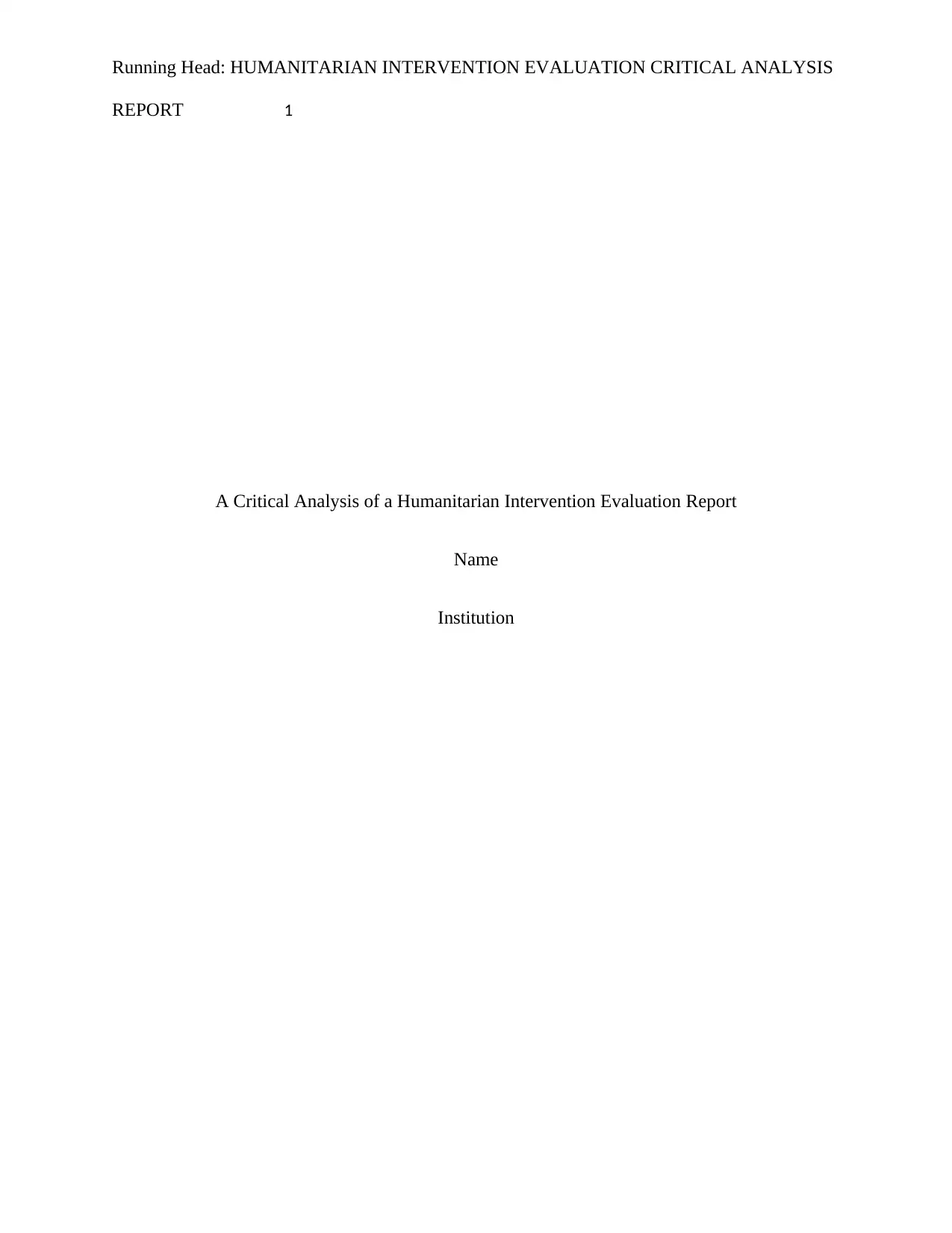
Running Head: HUMANITARIAN INTERVENTION EVALUATION CRITICAL ANALYSIS
REPORT 1
A Critical Analysis of a Humanitarian Intervention Evaluation Report
Name
Institution
REPORT 1
A Critical Analysis of a Humanitarian Intervention Evaluation Report
Name
Institution
Secure Best Marks with AI Grader
Need help grading? Try our AI Grader for instant feedback on your assignments.
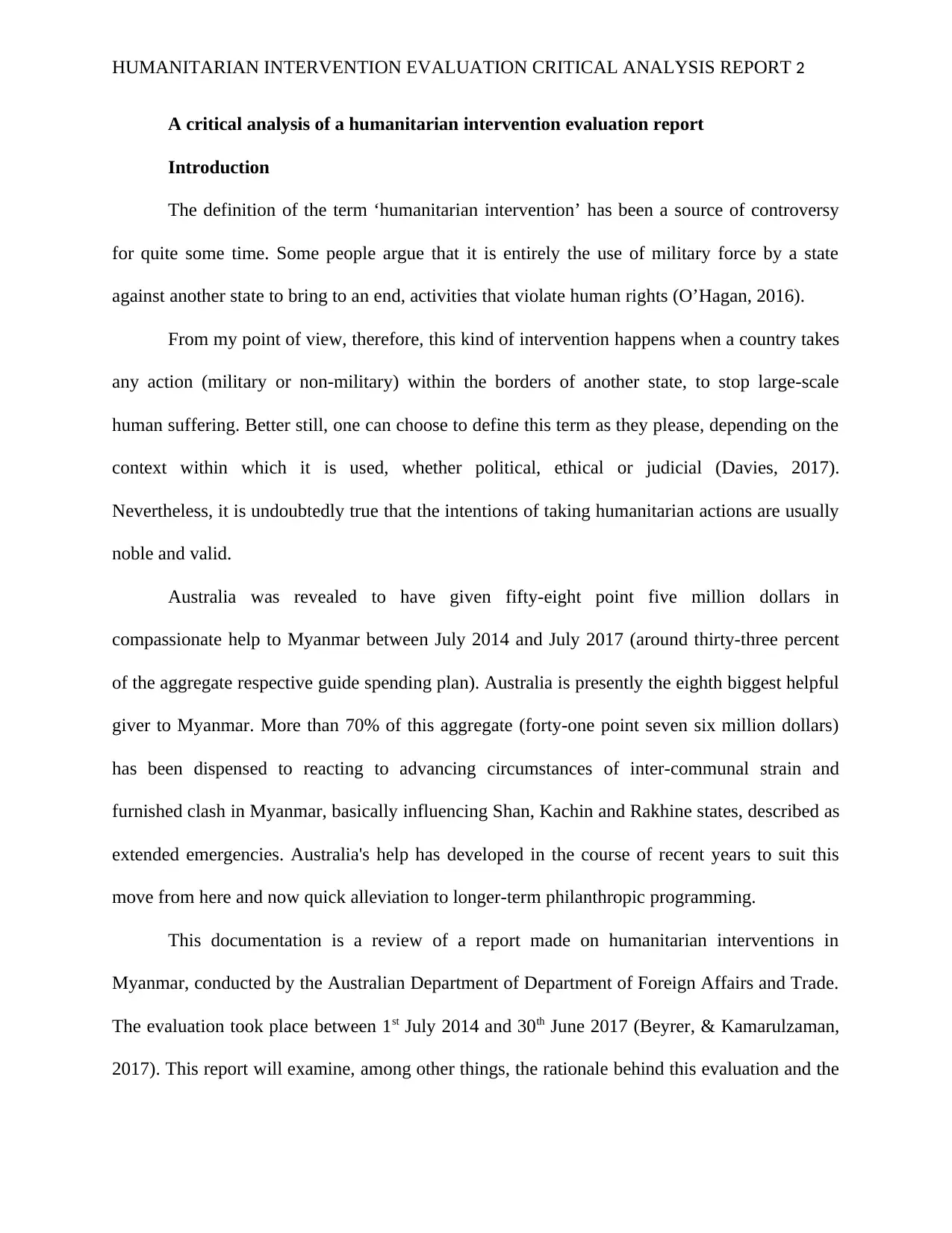
HUMANITARIAN INTERVENTION EVALUATION CRITICAL ANALYSIS REPORT 2
A critical analysis of a humanitarian intervention evaluation report
Introduction
The definition of the term ‘humanitarian intervention’ has been a source of controversy
for quite some time. Some people argue that it is entirely the use of military force by a state
against another state to bring to an end, activities that violate human rights (O’Hagan, 2016).
From my point of view, therefore, this kind of intervention happens when a country takes
any action (military or non-military) within the borders of another state, to stop large-scale
human suffering. Better still, one can choose to define this term as they please, depending on the
context within which it is used, whether political, ethical or judicial (Davies, 2017).
Nevertheless, it is undoubtedly true that the intentions of taking humanitarian actions are usually
noble and valid.
Australia was revealed to have given fifty-eight point five million dollars in
compassionate help to Myanmar between July 2014 and July 2017 (around thirty-three percent
of the aggregate respective guide spending plan). Australia is presently the eighth biggest helpful
giver to Myanmar. More than 70% of this aggregate (forty-one point seven six million dollars)
has been dispensed to reacting to advancing circumstances of inter-communal strain and
furnished clash in Myanmar, basically influencing Shan, Kachin and Rakhine states, described as
extended emergencies. Australia's help has developed in the course of recent years to suit this
move from here and now quick alleviation to longer-term philanthropic programming.
This documentation is a review of a report made on humanitarian interventions in
Myanmar, conducted by the Australian Department of Department of Foreign Affairs and Trade.
The evaluation took place between 1st July 2014 and 30th June 2017 (Beyrer, & Kamarulzaman,
2017). This report will examine, among other things, the rationale behind this evaluation and the
A critical analysis of a humanitarian intervention evaluation report
Introduction
The definition of the term ‘humanitarian intervention’ has been a source of controversy
for quite some time. Some people argue that it is entirely the use of military force by a state
against another state to bring to an end, activities that violate human rights (O’Hagan, 2016).
From my point of view, therefore, this kind of intervention happens when a country takes
any action (military or non-military) within the borders of another state, to stop large-scale
human suffering. Better still, one can choose to define this term as they please, depending on the
context within which it is used, whether political, ethical or judicial (Davies, 2017).
Nevertheless, it is undoubtedly true that the intentions of taking humanitarian actions are usually
noble and valid.
Australia was revealed to have given fifty-eight point five million dollars in
compassionate help to Myanmar between July 2014 and July 2017 (around thirty-three percent
of the aggregate respective guide spending plan). Australia is presently the eighth biggest helpful
giver to Myanmar. More than 70% of this aggregate (forty-one point seven six million dollars)
has been dispensed to reacting to advancing circumstances of inter-communal strain and
furnished clash in Myanmar, basically influencing Shan, Kachin and Rakhine states, described as
extended emergencies. Australia's help has developed in the course of recent years to suit this
move from here and now quick alleviation to longer-term philanthropic programming.
This documentation is a review of a report made on humanitarian interventions in
Myanmar, conducted by the Australian Department of Department of Foreign Affairs and Trade.
The evaluation took place between 1st July 2014 and 30th June 2017 (Beyrer, & Kamarulzaman,
2017). This report will examine, among other things, the rationale behind this evaluation and the
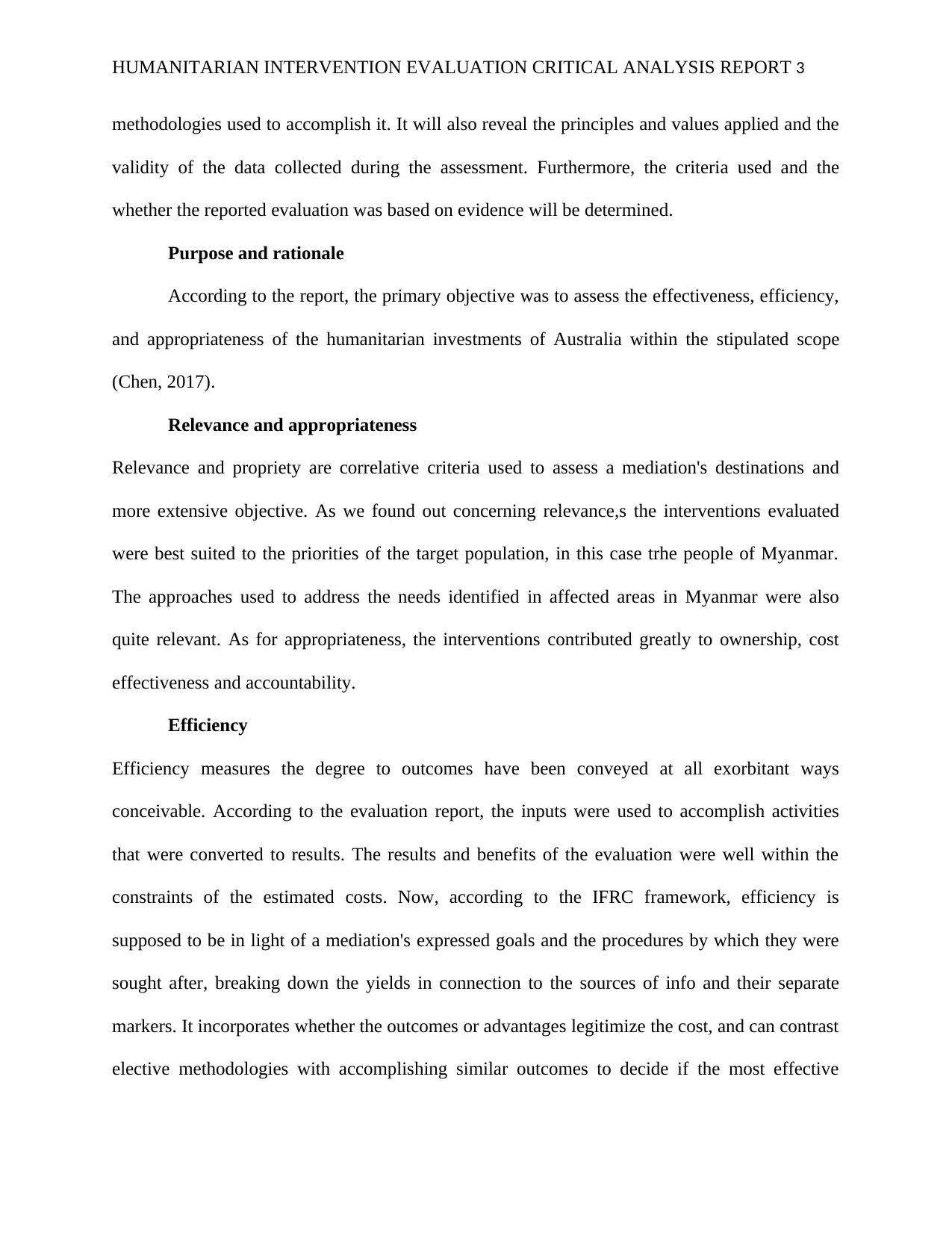
HUMANITARIAN INTERVENTION EVALUATION CRITICAL ANALYSIS REPORT 3
methodologies used to accomplish it. It will also reveal the principles and values applied and the
validity of the data collected during the assessment. Furthermore, the criteria used and the
whether the reported evaluation was based on evidence will be determined.
Purpose and rationale
According to the report, the primary objective was to assess the effectiveness, efficiency,
and appropriateness of the humanitarian investments of Australia within the stipulated scope
(Chen, 2017).
Relevance and appropriateness
Relevance and propriety are correlative criteria used to assess a mediation's destinations and
more extensive objective. As we found out concerning relevance,s the interventions evaluated
were best suited to the priorities of the target population, in this case trhe people of Myanmar.
The approaches used to address the needs identified in affected areas in Myanmar were also
quite relevant. As for appropriateness, the interventions contributed greatly to ownership, cost
effectiveness and accountability.
Efficiency
Efficiency measures the degree to outcomes have been conveyed at all exorbitant ways
conceivable. According to the evaluation report, the inputs were used to accomplish activities
that were converted to results. The results and benefits of the evaluation were well within the
constraints of the estimated costs. Now, according to the IFRC framework, efficiency is
supposed to be in light of a mediation's expressed goals and the procedures by which they were
sought after, breaking down the yields in connection to the sources of info and their separate
markers. It incorporates whether the outcomes or advantages legitimize the cost, and can contrast
elective methodologies with accomplishing similar outcomes to decide if the most effective
methodologies used to accomplish it. It will also reveal the principles and values applied and the
validity of the data collected during the assessment. Furthermore, the criteria used and the
whether the reported evaluation was based on evidence will be determined.
Purpose and rationale
According to the report, the primary objective was to assess the effectiveness, efficiency,
and appropriateness of the humanitarian investments of Australia within the stipulated scope
(Chen, 2017).
Relevance and appropriateness
Relevance and propriety are correlative criteria used to assess a mediation's destinations and
more extensive objective. As we found out concerning relevance,s the interventions evaluated
were best suited to the priorities of the target population, in this case trhe people of Myanmar.
The approaches used to address the needs identified in affected areas in Myanmar were also
quite relevant. As for appropriateness, the interventions contributed greatly to ownership, cost
effectiveness and accountability.
Efficiency
Efficiency measures the degree to outcomes have been conveyed at all exorbitant ways
conceivable. According to the evaluation report, the inputs were used to accomplish activities
that were converted to results. The results and benefits of the evaluation were well within the
constraints of the estimated costs. Now, according to the IFRC framework, efficiency is
supposed to be in light of a mediation's expressed goals and the procedures by which they were
sought after, breaking down the yields in connection to the sources of info and their separate
markers. It incorporates whether the outcomes or advantages legitimize the cost, and can contrast
elective methodologies with accomplishing similar outcomes to decide if the most effective
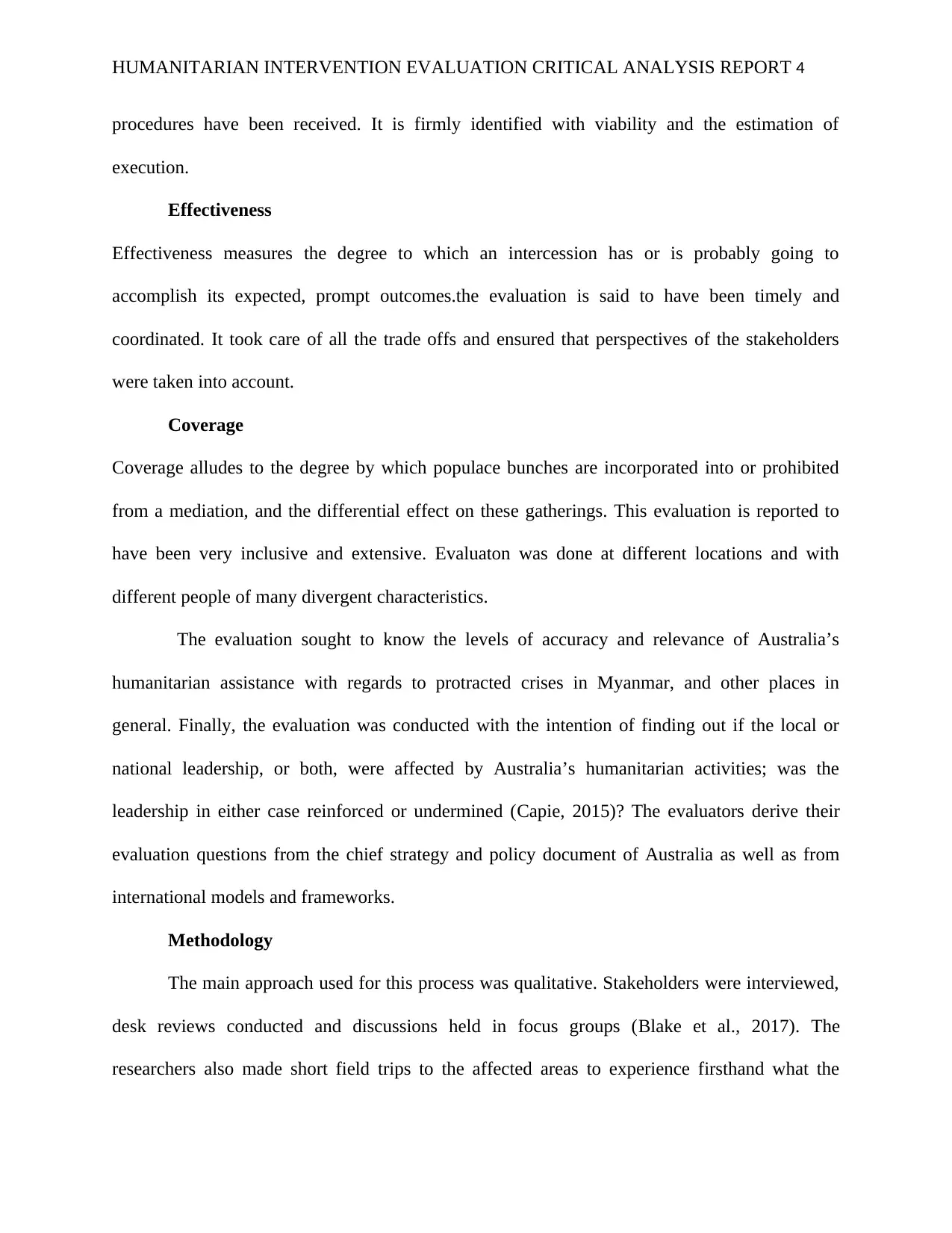
HUMANITARIAN INTERVENTION EVALUATION CRITICAL ANALYSIS REPORT 4
procedures have been received. It is firmly identified with viability and the estimation of
execution.
Effectiveness
Effectiveness measures the degree to which an intercession has or is probably going to
accomplish its expected, prompt outcomes.the evaluation is said to have been timely and
coordinated. It took care of all the trade offs and ensured that perspectives of the stakeholders
were taken into account.
Coverage
Coverage alludes to the degree by which populace bunches are incorporated into or prohibited
from a mediation, and the differential effect on these gatherings. This evaluation is reported to
have been very inclusive and extensive. Evaluaton was done at different locations and with
different people of many divergent characteristics.
The evaluation sought to know the levels of accuracy and relevance of Australia’s
humanitarian assistance with regards to protracted crises in Myanmar, and other places in
general. Finally, the evaluation was conducted with the intention of finding out if the local or
national leadership, or both, were affected by Australia’s humanitarian activities; was the
leadership in either case reinforced or undermined (Capie, 2015)? The evaluators derive their
evaluation questions from the chief strategy and policy document of Australia as well as from
international models and frameworks.
Methodology
The main approach used for this process was qualitative. Stakeholders were interviewed,
desk reviews conducted and discussions held in focus groups (Blake et al., 2017). The
researchers also made short field trips to the affected areas to experience firsthand what the
procedures have been received. It is firmly identified with viability and the estimation of
execution.
Effectiveness
Effectiveness measures the degree to which an intercession has or is probably going to
accomplish its expected, prompt outcomes.the evaluation is said to have been timely and
coordinated. It took care of all the trade offs and ensured that perspectives of the stakeholders
were taken into account.
Coverage
Coverage alludes to the degree by which populace bunches are incorporated into or prohibited
from a mediation, and the differential effect on these gatherings. This evaluation is reported to
have been very inclusive and extensive. Evaluaton was done at different locations and with
different people of many divergent characteristics.
The evaluation sought to know the levels of accuracy and relevance of Australia’s
humanitarian assistance with regards to protracted crises in Myanmar, and other places in
general. Finally, the evaluation was conducted with the intention of finding out if the local or
national leadership, or both, were affected by Australia’s humanitarian activities; was the
leadership in either case reinforced or undermined (Capie, 2015)? The evaluators derive their
evaluation questions from the chief strategy and policy document of Australia as well as from
international models and frameworks.
Methodology
The main approach used for this process was qualitative. Stakeholders were interviewed,
desk reviews conducted and discussions held in focus groups (Blake et al., 2017). The
researchers also made short field trips to the affected areas to experience firsthand what the
Secure Best Marks with AI Grader
Need help grading? Try our AI Grader for instant feedback on your assignments.
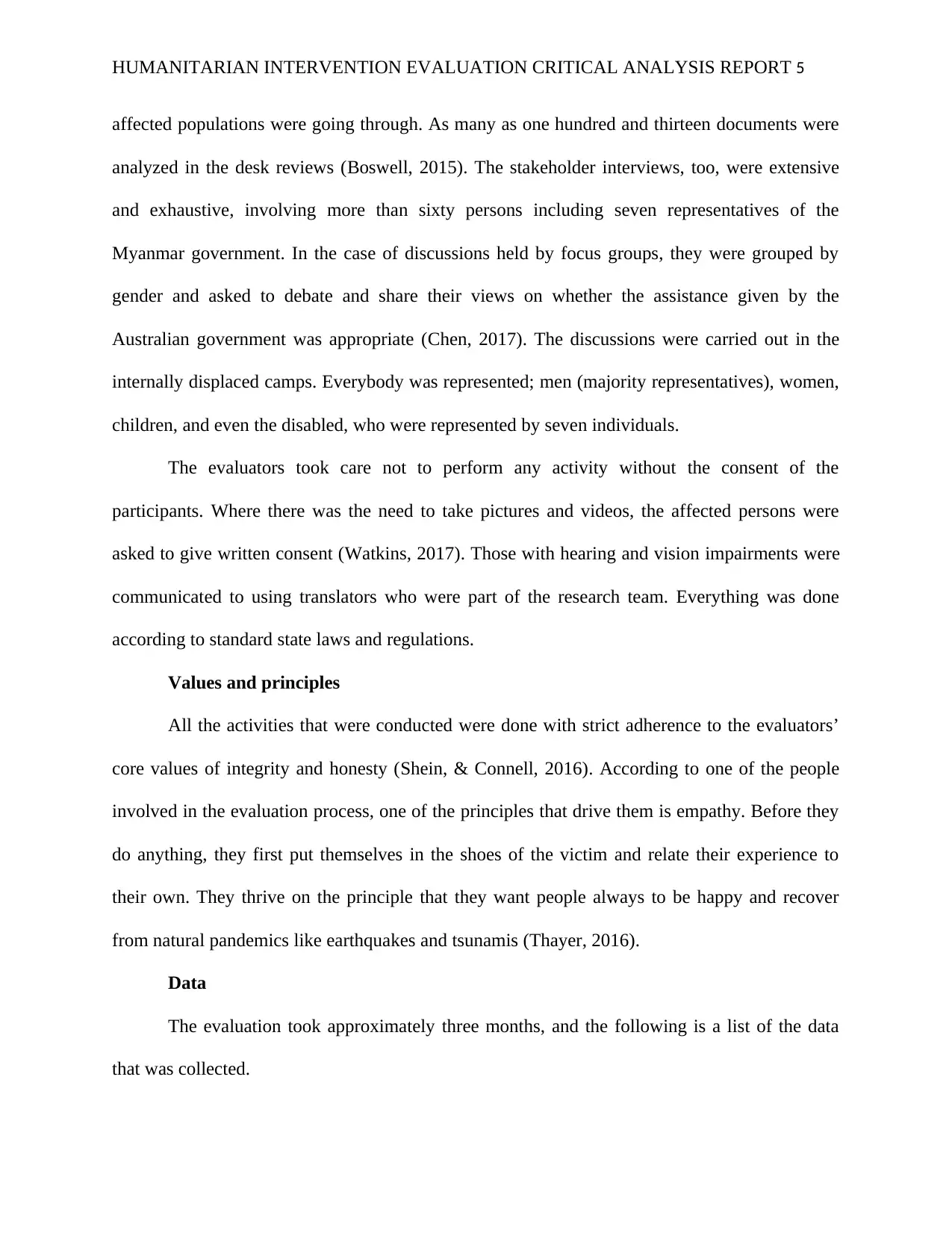
HUMANITARIAN INTERVENTION EVALUATION CRITICAL ANALYSIS REPORT 5
affected populations were going through. As many as one hundred and thirteen documents were
analyzed in the desk reviews (Boswell, 2015). The stakeholder interviews, too, were extensive
and exhaustive, involving more than sixty persons including seven representatives of the
Myanmar government. In the case of discussions held by focus groups, they were grouped by
gender and asked to debate and share their views on whether the assistance given by the
Australian government was appropriate (Chen, 2017). The discussions were carried out in the
internally displaced camps. Everybody was represented; men (majority representatives), women,
children, and even the disabled, who were represented by seven individuals.
The evaluators took care not to perform any activity without the consent of the
participants. Where there was the need to take pictures and videos, the affected persons were
asked to give written consent (Watkins, 2017). Those with hearing and vision impairments were
communicated to using translators who were part of the research team. Everything was done
according to standard state laws and regulations.
Values and principles
All the activities that were conducted were done with strict adherence to the evaluators’
core values of integrity and honesty (Shein, & Connell, 2016). According to one of the people
involved in the evaluation process, one of the principles that drive them is empathy. Before they
do anything, they first put themselves in the shoes of the victim and relate their experience to
their own. They thrive on the principle that they want people always to be happy and recover
from natural pandemics like earthquakes and tsunamis (Thayer, 2016).
Data
The evaluation took approximately three months, and the following is a list of the data
that was collected.
affected populations were going through. As many as one hundred and thirteen documents were
analyzed in the desk reviews (Boswell, 2015). The stakeholder interviews, too, were extensive
and exhaustive, involving more than sixty persons including seven representatives of the
Myanmar government. In the case of discussions held by focus groups, they were grouped by
gender and asked to debate and share their views on whether the assistance given by the
Australian government was appropriate (Chen, 2017). The discussions were carried out in the
internally displaced camps. Everybody was represented; men (majority representatives), women,
children, and even the disabled, who were represented by seven individuals.
The evaluators took care not to perform any activity without the consent of the
participants. Where there was the need to take pictures and videos, the affected persons were
asked to give written consent (Watkins, 2017). Those with hearing and vision impairments were
communicated to using translators who were part of the research team. Everything was done
according to standard state laws and regulations.
Values and principles
All the activities that were conducted were done with strict adherence to the evaluators’
core values of integrity and honesty (Shein, & Connell, 2016). According to one of the people
involved in the evaluation process, one of the principles that drive them is empathy. Before they
do anything, they first put themselves in the shoes of the victim and relate their experience to
their own. They thrive on the principle that they want people always to be happy and recover
from natural pandemics like earthquakes and tsunamis (Thayer, 2016).
Data
The evaluation took approximately three months, and the following is a list of the data
that was collected.
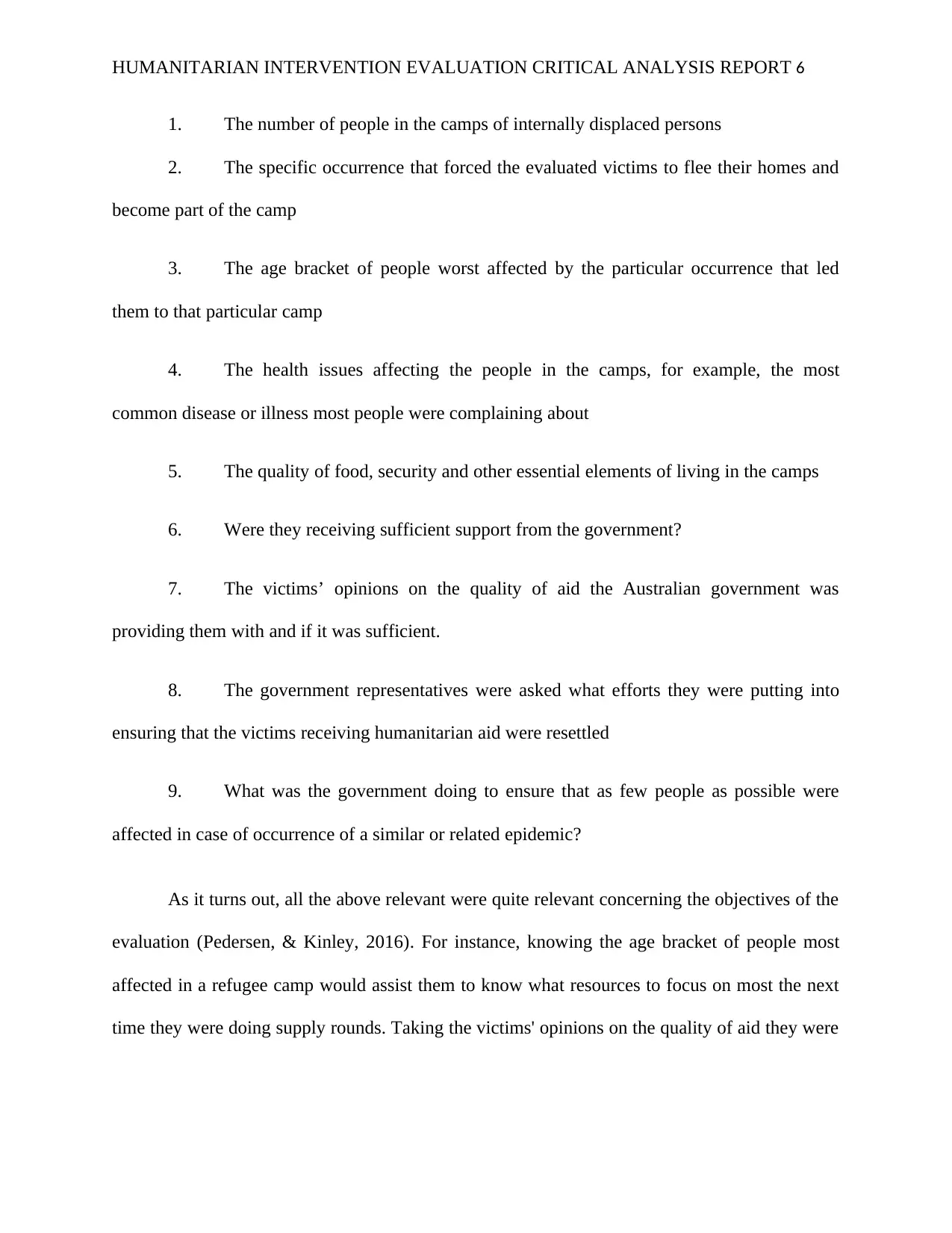
HUMANITARIAN INTERVENTION EVALUATION CRITICAL ANALYSIS REPORT 6
1. The number of people in the camps of internally displaced persons
2. The specific occurrence that forced the evaluated victims to flee their homes and
become part of the camp
3. The age bracket of people worst affected by the particular occurrence that led
them to that particular camp
4. The health issues affecting the people in the camps, for example, the most
common disease or illness most people were complaining about
5. The quality of food, security and other essential elements of living in the camps
6. Were they receiving sufficient support from the government?
7. The victims’ opinions on the quality of aid the Australian government was
providing them with and if it was sufficient.
8. The government representatives were asked what efforts they were putting into
ensuring that the victims receiving humanitarian aid were resettled
9. What was the government doing to ensure that as few people as possible were
affected in case of occurrence of a similar or related epidemic?
As it turns out, all the above relevant were quite relevant concerning the objectives of the
evaluation (Pedersen, & Kinley, 2016). For instance, knowing the age bracket of people most
affected in a refugee camp would assist them to know what resources to focus on most the next
time they were doing supply rounds. Taking the victims' opinions on the quality of aid they were
1. The number of people in the camps of internally displaced persons
2. The specific occurrence that forced the evaluated victims to flee their homes and
become part of the camp
3. The age bracket of people worst affected by the particular occurrence that led
them to that particular camp
4. The health issues affecting the people in the camps, for example, the most
common disease or illness most people were complaining about
5. The quality of food, security and other essential elements of living in the camps
6. Were they receiving sufficient support from the government?
7. The victims’ opinions on the quality of aid the Australian government was
providing them with and if it was sufficient.
8. The government representatives were asked what efforts they were putting into
ensuring that the victims receiving humanitarian aid were resettled
9. What was the government doing to ensure that as few people as possible were
affected in case of occurrence of a similar or related epidemic?
As it turns out, all the above relevant were quite relevant concerning the objectives of the
evaluation (Pedersen, & Kinley, 2016). For instance, knowing the age bracket of people most
affected in a refugee camp would assist them to know what resources to focus on most the next
time they were doing supply rounds. Taking the victims' opinions on the quality of aid they were
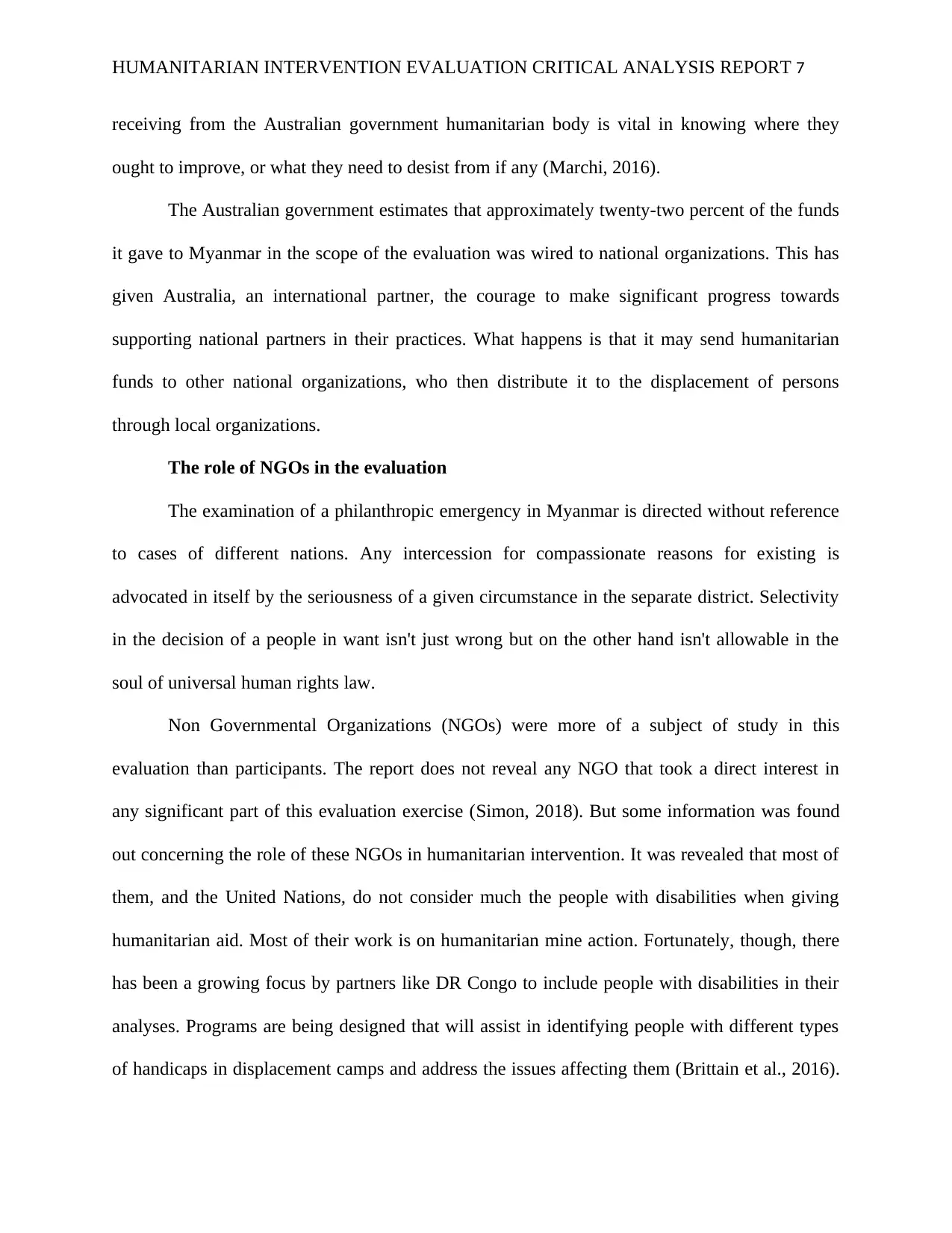
HUMANITARIAN INTERVENTION EVALUATION CRITICAL ANALYSIS REPORT 7
receiving from the Australian government humanitarian body is vital in knowing where they
ought to improve, or what they need to desist from if any (Marchi, 2016).
The Australian government estimates that approximately twenty-two percent of the funds
it gave to Myanmar in the scope of the evaluation was wired to national organizations. This has
given Australia, an international partner, the courage to make significant progress towards
supporting national partners in their practices. What happens is that it may send humanitarian
funds to other national organizations, who then distribute it to the displacement of persons
through local organizations.
The role of NGOs in the evaluation
The examination of a philanthropic emergency in Myanmar is directed without reference
to cases of different nations. Any intercession for compassionate reasons for existing is
advocated in itself by the seriousness of a given circumstance in the separate district. Selectivity
in the decision of a people in want isn't just wrong but on the other hand isn't allowable in the
soul of universal human rights law.
Non Governmental Organizations (NGOs) were more of a subject of study in this
evaluation than participants. The report does not reveal any NGO that took a direct interest in
any significant part of this evaluation exercise (Simon, 2018). But some information was found
out concerning the role of these NGOs in humanitarian intervention. It was revealed that most of
them, and the United Nations, do not consider much the people with disabilities when giving
humanitarian aid. Most of their work is on humanitarian mine action. Fortunately, though, there
has been a growing focus by partners like DR Congo to include people with disabilities in their
analyses. Programs are being designed that will assist in identifying people with different types
of handicaps in displacement camps and address the issues affecting them (Brittain et al., 2016).
receiving from the Australian government humanitarian body is vital in knowing where they
ought to improve, or what they need to desist from if any (Marchi, 2016).
The Australian government estimates that approximately twenty-two percent of the funds
it gave to Myanmar in the scope of the evaluation was wired to national organizations. This has
given Australia, an international partner, the courage to make significant progress towards
supporting national partners in their practices. What happens is that it may send humanitarian
funds to other national organizations, who then distribute it to the displacement of persons
through local organizations.
The role of NGOs in the evaluation
The examination of a philanthropic emergency in Myanmar is directed without reference
to cases of different nations. Any intercession for compassionate reasons for existing is
advocated in itself by the seriousness of a given circumstance in the separate district. Selectivity
in the decision of a people in want isn't just wrong but on the other hand isn't allowable in the
soul of universal human rights law.
Non Governmental Organizations (NGOs) were more of a subject of study in this
evaluation than participants. The report does not reveal any NGO that took a direct interest in
any significant part of this evaluation exercise (Simon, 2018). But some information was found
out concerning the role of these NGOs in humanitarian intervention. It was revealed that most of
them, and the United Nations, do not consider much the people with disabilities when giving
humanitarian aid. Most of their work is on humanitarian mine action. Fortunately, though, there
has been a growing focus by partners like DR Congo to include people with disabilities in their
analyses. Programs are being designed that will assist in identifying people with different types
of handicaps in displacement camps and address the issues affecting them (Brittain et al., 2016).
Paraphrase This Document
Need a fresh take? Get an instant paraphrase of this document with our AI Paraphraser
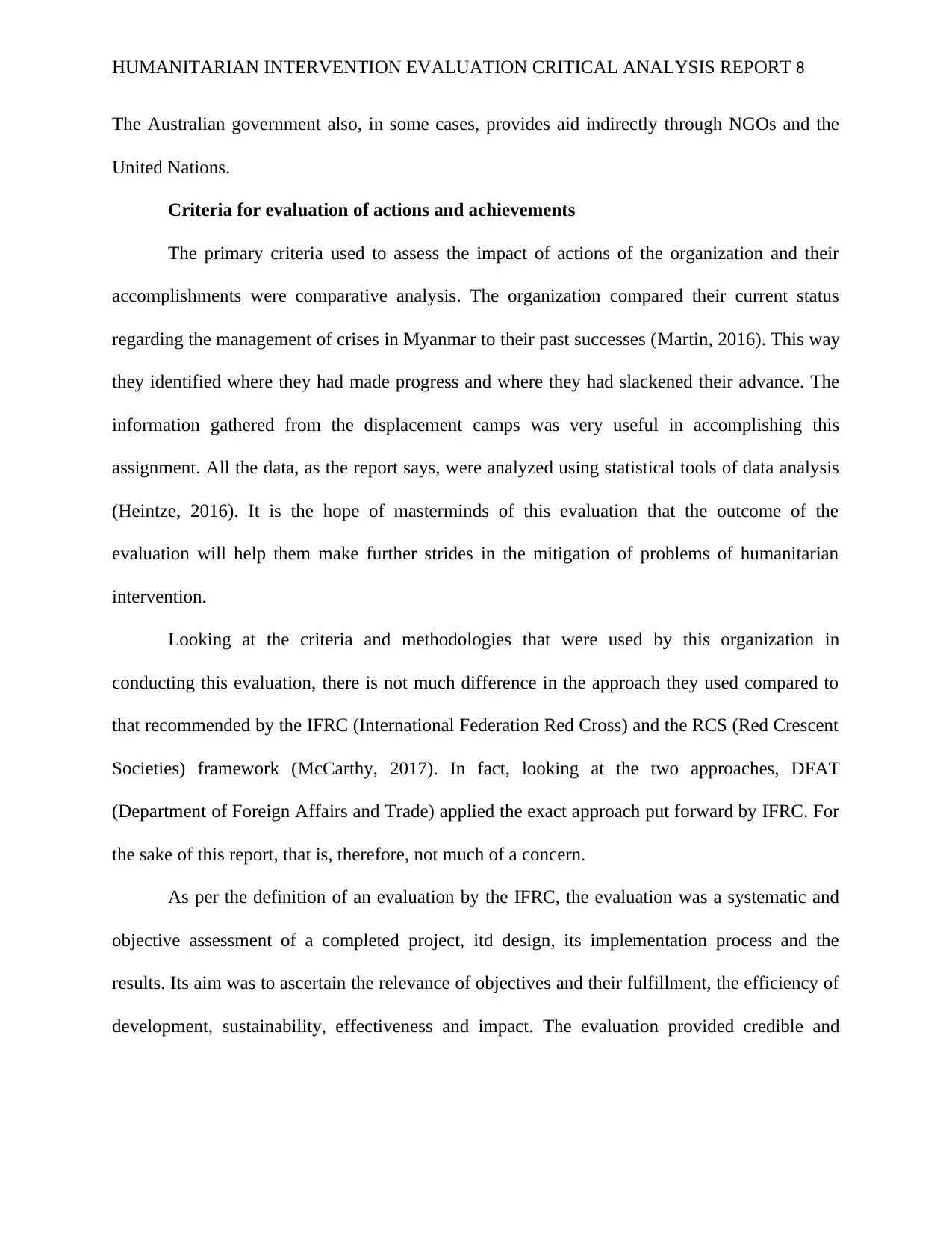
HUMANITARIAN INTERVENTION EVALUATION CRITICAL ANALYSIS REPORT 8
The Australian government also, in some cases, provides aid indirectly through NGOs and the
United Nations.
Criteria for evaluation of actions and achievements
The primary criteria used to assess the impact of actions of the organization and their
accomplishments were comparative analysis. The organization compared their current status
regarding the management of crises in Myanmar to their past successes (Martin, 2016). This way
they identified where they had made progress and where they had slackened their advance. The
information gathered from the displacement camps was very useful in accomplishing this
assignment. All the data, as the report says, were analyzed using statistical tools of data analysis
(Heintze, 2016). It is the hope of masterminds of this evaluation that the outcome of the
evaluation will help them make further strides in the mitigation of problems of humanitarian
intervention.
Looking at the criteria and methodologies that were used by this organization in
conducting this evaluation, there is not much difference in the approach they used compared to
that recommended by the IFRC (International Federation Red Cross) and the RCS (Red Crescent
Societies) framework (McCarthy, 2017). In fact, looking at the two approaches, DFAT
(Department of Foreign Affairs and Trade) applied the exact approach put forward by IFRC. For
the sake of this report, that is, therefore, not much of a concern.
As per the definition of an evaluation by the IFRC, the evaluation was a systematic and
objective assessment of a completed project, itd design, its implementation process and the
results. Its aim was to ascertain the relevance of objectives and their fulfillment, the efficiency of
development, sustainability, effectiveness and impact. The evaluation provided credible and
The Australian government also, in some cases, provides aid indirectly through NGOs and the
United Nations.
Criteria for evaluation of actions and achievements
The primary criteria used to assess the impact of actions of the organization and their
accomplishments were comparative analysis. The organization compared their current status
regarding the management of crises in Myanmar to their past successes (Martin, 2016). This way
they identified where they had made progress and where they had slackened their advance. The
information gathered from the displacement camps was very useful in accomplishing this
assignment. All the data, as the report says, were analyzed using statistical tools of data analysis
(Heintze, 2016). It is the hope of masterminds of this evaluation that the outcome of the
evaluation will help them make further strides in the mitigation of problems of humanitarian
intervention.
Looking at the criteria and methodologies that were used by this organization in
conducting this evaluation, there is not much difference in the approach they used compared to
that recommended by the IFRC (International Federation Red Cross) and the RCS (Red Crescent
Societies) framework (McCarthy, 2017). In fact, looking at the two approaches, DFAT
(Department of Foreign Affairs and Trade) applied the exact approach put forward by IFRC. For
the sake of this report, that is, therefore, not much of a concern.
As per the definition of an evaluation by the IFRC, the evaluation was a systematic and
objective assessment of a completed project, itd design, its implementation process and the
results. Its aim was to ascertain the relevance of objectives and their fulfillment, the efficiency of
development, sustainability, effectiveness and impact. The evaluation provided credible and
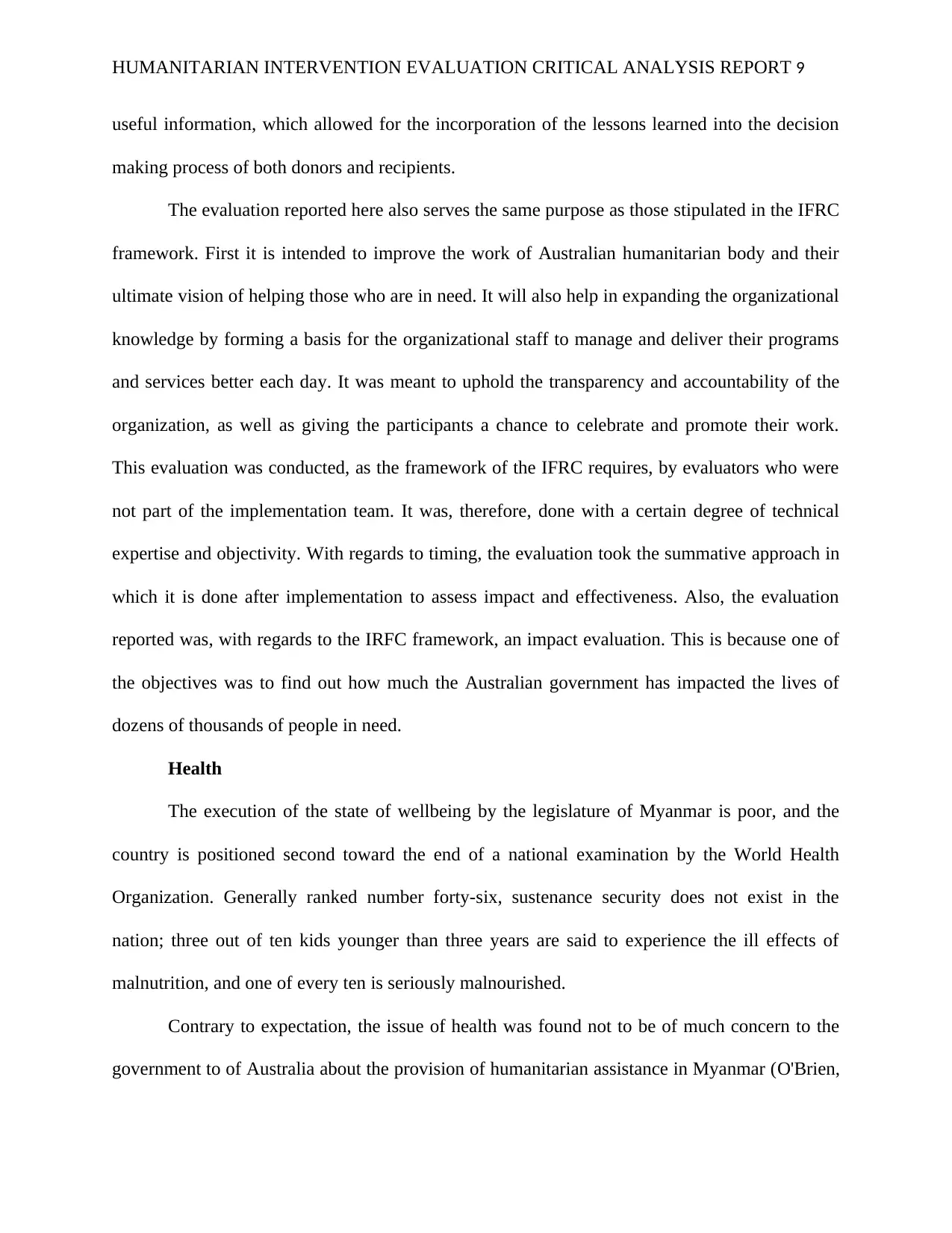
HUMANITARIAN INTERVENTION EVALUATION CRITICAL ANALYSIS REPORT 9
useful information, which allowed for the incorporation of the lessons learned into the decision
making process of both donors and recipients.
The evaluation reported here also serves the same purpose as those stipulated in the IFRC
framework. First it is intended to improve the work of Australian humanitarian body and their
ultimate vision of helping those who are in need. It will also help in expanding the organizational
knowledge by forming a basis for the organizational staff to manage and deliver their programs
and services better each day. It was meant to uphold the transparency and accountability of the
organization, as well as giving the participants a chance to celebrate and promote their work.
This evaluation was conducted, as the framework of the IFRC requires, by evaluators who were
not part of the implementation team. It was, therefore, done with a certain degree of technical
expertise and objectivity. With regards to timing, the evaluation took the summative approach in
which it is done after implementation to assess impact and effectiveness. Also, the evaluation
reported was, with regards to the IRFC framework, an impact evaluation. This is because one of
the objectives was to find out how much the Australian government has impacted the lives of
dozens of thousands of people in need.
Health
The execution of the state of wellbeing by the legislature of Myanmar is poor, and the
country is positioned second toward the end of a national examination by the World Health
Organization. Generally ranked number forty-six, sustenance security does not exist in the
nation; three out of ten kids younger than three years are said to experience the ill effects of
malnutrition, and one of every ten is seriously malnourished.
Contrary to expectation, the issue of health was found not to be of much concern to the
government to of Australia about the provision of humanitarian assistance in Myanmar (O'Brien,
useful information, which allowed for the incorporation of the lessons learned into the decision
making process of both donors and recipients.
The evaluation reported here also serves the same purpose as those stipulated in the IFRC
framework. First it is intended to improve the work of Australian humanitarian body and their
ultimate vision of helping those who are in need. It will also help in expanding the organizational
knowledge by forming a basis for the organizational staff to manage and deliver their programs
and services better each day. It was meant to uphold the transparency and accountability of the
organization, as well as giving the participants a chance to celebrate and promote their work.
This evaluation was conducted, as the framework of the IFRC requires, by evaluators who were
not part of the implementation team. It was, therefore, done with a certain degree of technical
expertise and objectivity. With regards to timing, the evaluation took the summative approach in
which it is done after implementation to assess impact and effectiveness. Also, the evaluation
reported was, with regards to the IRFC framework, an impact evaluation. This is because one of
the objectives was to find out how much the Australian government has impacted the lives of
dozens of thousands of people in need.
Health
The execution of the state of wellbeing by the legislature of Myanmar is poor, and the
country is positioned second toward the end of a national examination by the World Health
Organization. Generally ranked number forty-six, sustenance security does not exist in the
nation; three out of ten kids younger than three years are said to experience the ill effects of
malnutrition, and one of every ten is seriously malnourished.
Contrary to expectation, the issue of health was found not to be of much concern to the
government to of Australia about the provision of humanitarian assistance in Myanmar (O'Brien,
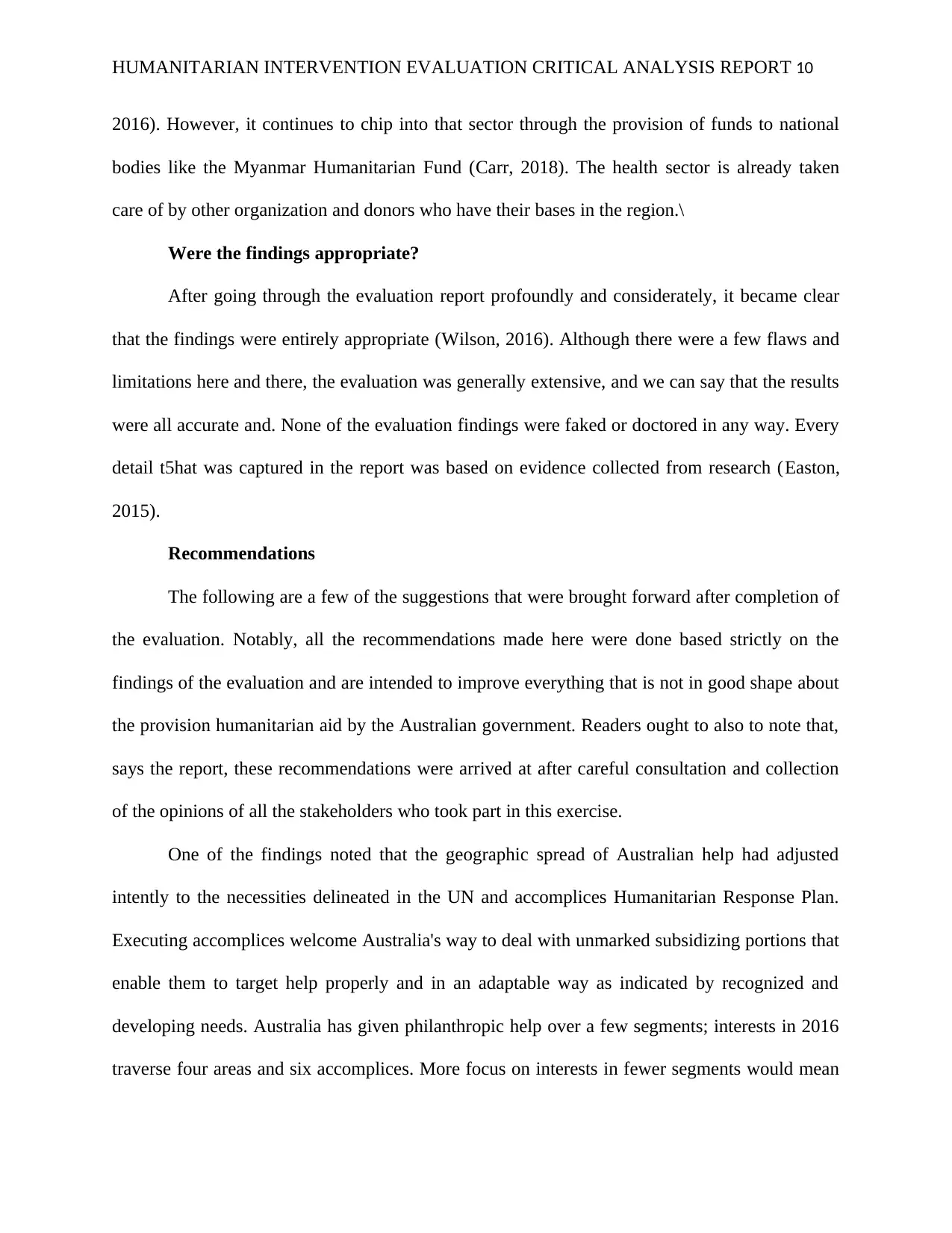
HUMANITARIAN INTERVENTION EVALUATION CRITICAL ANALYSIS REPORT 10
2016). However, it continues to chip into that sector through the provision of funds to national
bodies like the Myanmar Humanitarian Fund (Carr, 2018). The health sector is already taken
care of by other organization and donors who have their bases in the region.\
Were the findings appropriate?
After going through the evaluation report profoundly and considerately, it became clear
that the findings were entirely appropriate (Wilson, 2016). Although there were a few flaws and
limitations here and there, the evaluation was generally extensive, and we can say that the results
were all accurate and. None of the evaluation findings were faked or doctored in any way. Every
detail t5hat was captured in the report was based on evidence collected from research (Easton,
2015).
Recommendations
The following are a few of the suggestions that were brought forward after completion of
the evaluation. Notably, all the recommendations made here were done based strictly on the
findings of the evaluation and are intended to improve everything that is not in good shape about
the provision humanitarian aid by the Australian government. Readers ought to also to note that,
says the report, these recommendations were arrived at after careful consultation and collection
of the opinions of all the stakeholders who took part in this exercise.
One of the findings noted that the geographic spread of Australian help had adjusted
intently to the necessities delineated in the UN and accomplices Humanitarian Response Plan.
Executing accomplices welcome Australia's way to deal with unmarked subsidizing portions that
enable them to target help properly and in an adaptable way as indicated by recognized and
developing needs. Australia has given philanthropic help over a few segments; interests in 2016
traverse four areas and six accomplices. More focus on interests in fewer segments would mean
2016). However, it continues to chip into that sector through the provision of funds to national
bodies like the Myanmar Humanitarian Fund (Carr, 2018). The health sector is already taken
care of by other organization and donors who have their bases in the region.\
Were the findings appropriate?
After going through the evaluation report profoundly and considerately, it became clear
that the findings were entirely appropriate (Wilson, 2016). Although there were a few flaws and
limitations here and there, the evaluation was generally extensive, and we can say that the results
were all accurate and. None of the evaluation findings were faked or doctored in any way. Every
detail t5hat was captured in the report was based on evidence collected from research (Easton,
2015).
Recommendations
The following are a few of the suggestions that were brought forward after completion of
the evaluation. Notably, all the recommendations made here were done based strictly on the
findings of the evaluation and are intended to improve everything that is not in good shape about
the provision humanitarian aid by the Australian government. Readers ought to also to note that,
says the report, these recommendations were arrived at after careful consultation and collection
of the opinions of all the stakeholders who took part in this exercise.
One of the findings noted that the geographic spread of Australian help had adjusted
intently to the necessities delineated in the UN and accomplices Humanitarian Response Plan.
Executing accomplices welcome Australia's way to deal with unmarked subsidizing portions that
enable them to target help properly and in an adaptable way as indicated by recognized and
developing needs. Australia has given philanthropic help over a few segments; interests in 2016
traverse four areas and six accomplices. More focus on interests in fewer segments would mean
Secure Best Marks with AI Grader
Need help grading? Try our AI Grader for instant feedback on your assignments.
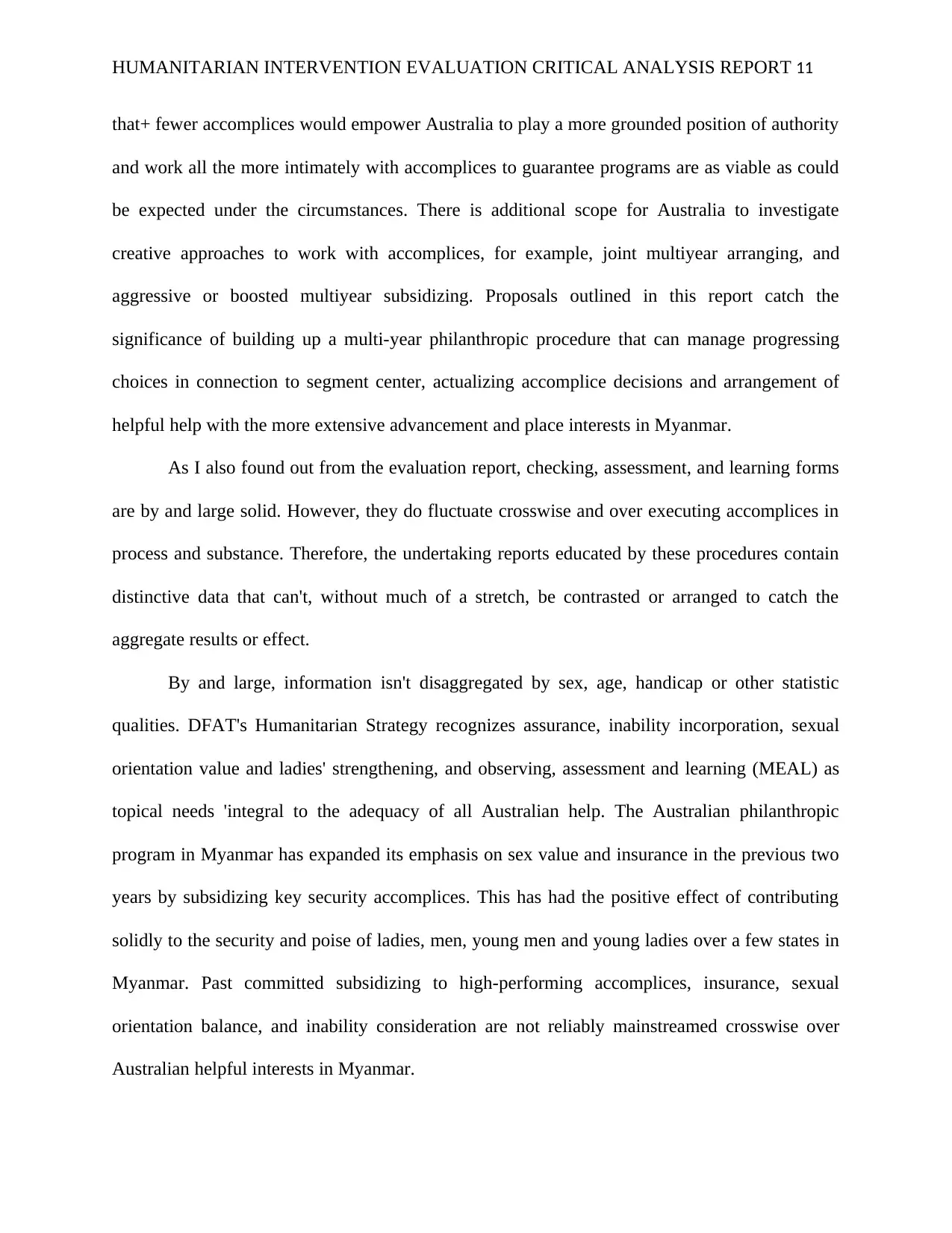
HUMANITARIAN INTERVENTION EVALUATION CRITICAL ANALYSIS REPORT 11
that+ fewer accomplices would empower Australia to play a more grounded position of authority
and work all the more intimately with accomplices to guarantee programs are as viable as could
be expected under the circumstances. There is additional scope for Australia to investigate
creative approaches to work with accomplices, for example, joint multiyear arranging, and
aggressive or boosted multiyear subsidizing. Proposals outlined in this report catch the
significance of building up a multi-year philanthropic procedure that can manage progressing
choices in connection to segment center, actualizing accomplice decisions and arrangement of
helpful help with the more extensive advancement and place interests in Myanmar.
As I also found out from the evaluation report, checking, assessment, and learning forms
are by and large solid. However, they do fluctuate crosswise and over executing accomplices in
process and substance. Therefore, the undertaking reports educated by these procedures contain
distinctive data that can't, without much of a stretch, be contrasted or arranged to catch the
aggregate results or effect.
By and large, information isn't disaggregated by sex, age, handicap or other statistic
qualities. DFAT's Humanitarian Strategy recognizes assurance, inability incorporation, sexual
orientation value and ladies' strengthening, and observing, assessment and learning (MEAL) as
topical needs 'integral to the adequacy of all Australian help. The Australian philanthropic
program in Myanmar has expanded its emphasis on sex value and insurance in the previous two
years by subsidizing key security accomplices. This has had the positive effect of contributing
solidly to the security and poise of ladies, men, young men and young ladies over a few states in
Myanmar. Past committed subsidizing to high-performing accomplices, insurance, sexual
orientation balance, and inability consideration are not reliably mainstreamed crosswise over
Australian helpful interests in Myanmar.
that+ fewer accomplices would empower Australia to play a more grounded position of authority
and work all the more intimately with accomplices to guarantee programs are as viable as could
be expected under the circumstances. There is additional scope for Australia to investigate
creative approaches to work with accomplices, for example, joint multiyear arranging, and
aggressive or boosted multiyear subsidizing. Proposals outlined in this report catch the
significance of building up a multi-year philanthropic procedure that can manage progressing
choices in connection to segment center, actualizing accomplice decisions and arrangement of
helpful help with the more extensive advancement and place interests in Myanmar.
As I also found out from the evaluation report, checking, assessment, and learning forms
are by and large solid. However, they do fluctuate crosswise and over executing accomplices in
process and substance. Therefore, the undertaking reports educated by these procedures contain
distinctive data that can't, without much of a stretch, be contrasted or arranged to catch the
aggregate results or effect.
By and large, information isn't disaggregated by sex, age, handicap or other statistic
qualities. DFAT's Humanitarian Strategy recognizes assurance, inability incorporation, sexual
orientation value and ladies' strengthening, and observing, assessment and learning (MEAL) as
topical needs 'integral to the adequacy of all Australian help. The Australian philanthropic
program in Myanmar has expanded its emphasis on sex value and insurance in the previous two
years by subsidizing key security accomplices. This has had the positive effect of contributing
solidly to the security and poise of ladies, men, young men and young ladies over a few states in
Myanmar. Past committed subsidizing to high-performing accomplices, insurance, sexual
orientation balance, and inability consideration are not reliably mainstreamed crosswise over
Australian helpful interests in Myanmar.
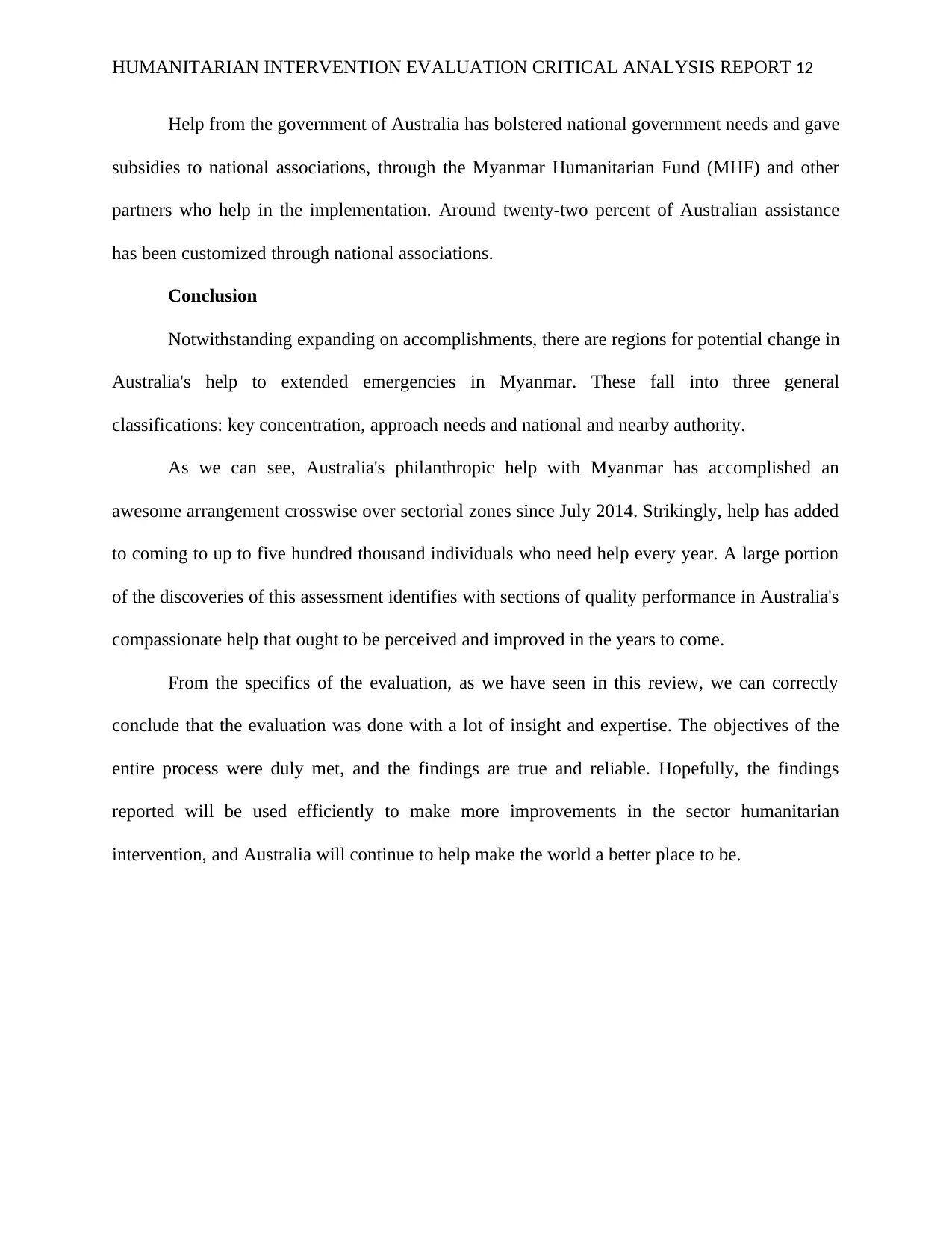
HUMANITARIAN INTERVENTION EVALUATION CRITICAL ANALYSIS REPORT 12
Help from the government of Australia has bolstered national government needs and gave
subsidies to national associations, through the Myanmar Humanitarian Fund (MHF) and other
partners who help in the implementation. Around twenty-two percent of Australian assistance
has been customized through national associations.
Conclusion
Notwithstanding expanding on accomplishments, there are regions for potential change in
Australia's help to extended emergencies in Myanmar. These fall into three general
classifications: key concentration, approach needs and national and nearby authority.
As we can see, Australia's philanthropic help with Myanmar has accomplished an
awesome arrangement crosswise over sectorial zones since July 2014. Strikingly, help has added
to coming to up to five hundred thousand individuals who need help every year. A large portion
of the discoveries of this assessment identifies with sections of quality performance in Australia's
compassionate help that ought to be perceived and improved in the years to come.
From the specifics of the evaluation, as we have seen in this review, we can correctly
conclude that the evaluation was done with a lot of insight and expertise. The objectives of the
entire process were duly met, and the findings are true and reliable. Hopefully, the findings
reported will be used efficiently to make more improvements in the sector humanitarian
intervention, and Australia will continue to help make the world a better place to be.
Help from the government of Australia has bolstered national government needs and gave
subsidies to national associations, through the Myanmar Humanitarian Fund (MHF) and other
partners who help in the implementation. Around twenty-two percent of Australian assistance
has been customized through national associations.
Conclusion
Notwithstanding expanding on accomplishments, there are regions for potential change in
Australia's help to extended emergencies in Myanmar. These fall into three general
classifications: key concentration, approach needs and national and nearby authority.
As we can see, Australia's philanthropic help with Myanmar has accomplished an
awesome arrangement crosswise over sectorial zones since July 2014. Strikingly, help has added
to coming to up to five hundred thousand individuals who need help every year. A large portion
of the discoveries of this assessment identifies with sections of quality performance in Australia's
compassionate help that ought to be perceived and improved in the years to come.
From the specifics of the evaluation, as we have seen in this review, we can correctly
conclude that the evaluation was done with a lot of insight and expertise. The objectives of the
entire process were duly met, and the findings are true and reliable. Hopefully, the findings
reported will be used efficiently to make more improvements in the sector humanitarian
intervention, and Australia will continue to help make the world a better place to be.
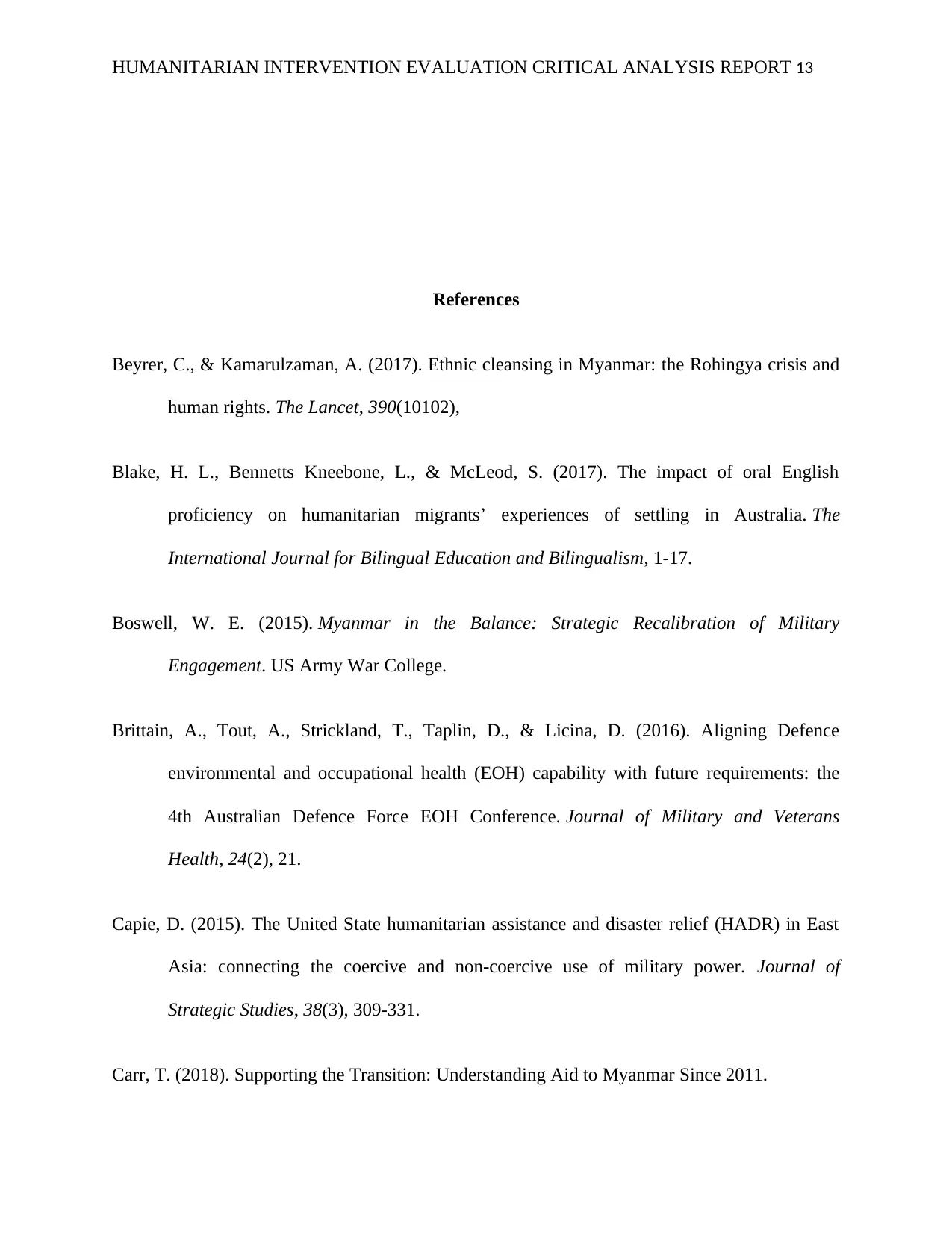
HUMANITARIAN INTERVENTION EVALUATION CRITICAL ANALYSIS REPORT 13
References
Beyrer, C., & Kamarulzaman, A. (2017). Ethnic cleansing in Myanmar: the Rohingya crisis and
human rights. The Lancet, 390(10102),
Blake, H. L., Bennetts Kneebone, L., & McLeod, S. (2017). The impact of oral English
proficiency on humanitarian migrants’ experiences of settling in Australia. The
International Journal for Bilingual Education and Bilingualism, 1-17.
Boswell, W. E. (2015). Myanmar in the Balance: Strategic Recalibration of Military
Engagement. US Army War College.
Brittain, A., Tout, A., Strickland, T., Taplin, D., & Licina, D. (2016). Aligning Defence
environmental and occupational health (EOH) capability with future requirements: the
4th Australian Defence Force EOH Conference. Journal of Military and Veterans
Health, 24(2), 21.
Capie, D. (2015). The United State humanitarian assistance and disaster relief (HADR) in East
Asia: connecting the coercive and non-coercive use of military power. Journal of
Strategic Studies, 38(3), 309-331.
Carr, T. (2018). Supporting the Transition: Understanding Aid to Myanmar Since 2011.
References
Beyrer, C., & Kamarulzaman, A. (2017). Ethnic cleansing in Myanmar: the Rohingya crisis and
human rights. The Lancet, 390(10102),
Blake, H. L., Bennetts Kneebone, L., & McLeod, S. (2017). The impact of oral English
proficiency on humanitarian migrants’ experiences of settling in Australia. The
International Journal for Bilingual Education and Bilingualism, 1-17.
Boswell, W. E. (2015). Myanmar in the Balance: Strategic Recalibration of Military
Engagement. US Army War College.
Brittain, A., Tout, A., Strickland, T., Taplin, D., & Licina, D. (2016). Aligning Defence
environmental and occupational health (EOH) capability with future requirements: the
4th Australian Defence Force EOH Conference. Journal of Military and Veterans
Health, 24(2), 21.
Capie, D. (2015). The United State humanitarian assistance and disaster relief (HADR) in East
Asia: connecting the coercive and non-coercive use of military power. Journal of
Strategic Studies, 38(3), 309-331.
Carr, T. (2018). Supporting the Transition: Understanding Aid to Myanmar Since 2011.
Paraphrase This Document
Need a fresh take? Get an instant paraphrase of this document with our AI Paraphraser
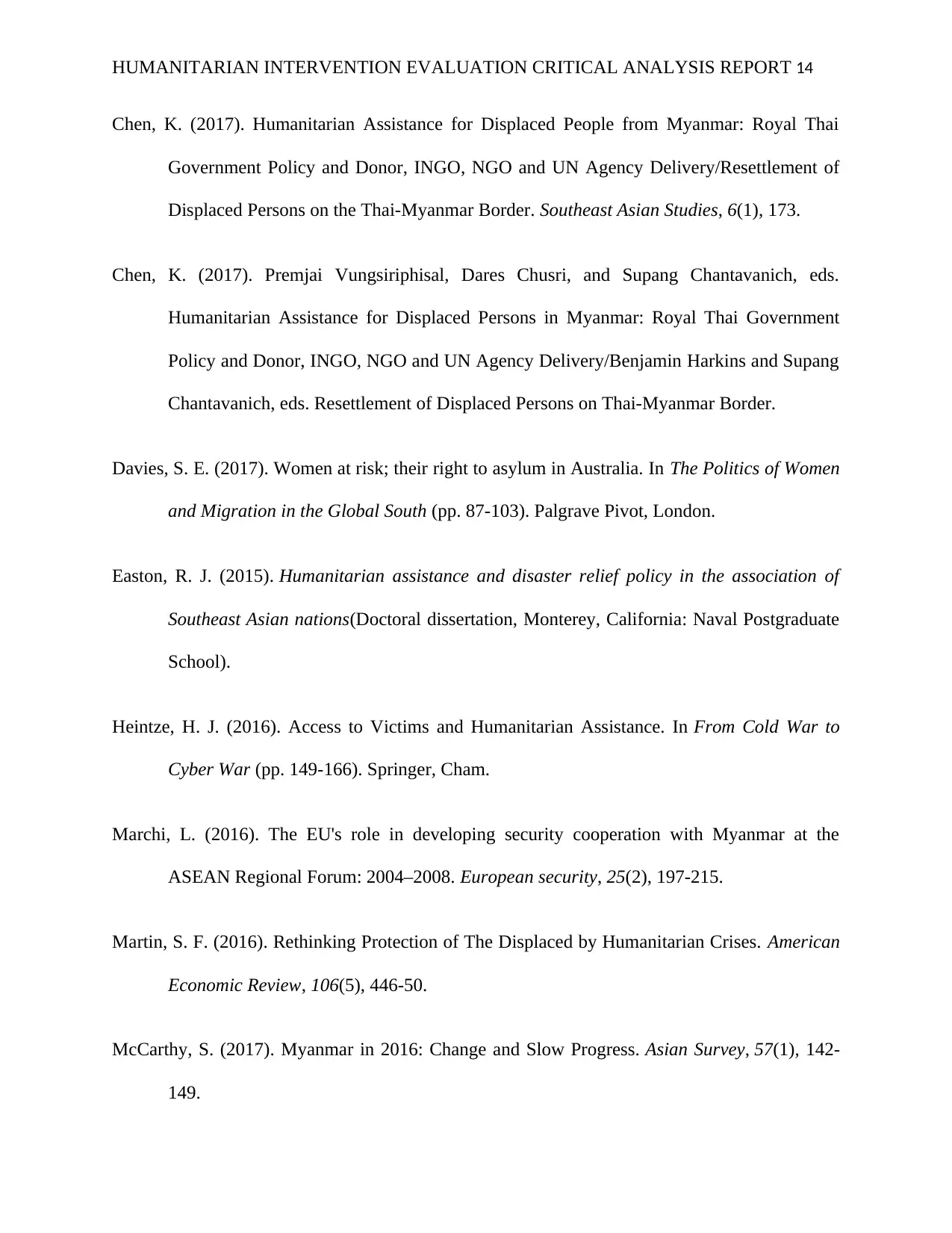
HUMANITARIAN INTERVENTION EVALUATION CRITICAL ANALYSIS REPORT 14
Chen, K. (2017). Humanitarian Assistance for Displaced People from Myanmar: Royal Thai
Government Policy and Donor, INGO, NGO and UN Agency Delivery/Resettlement of
Displaced Persons on the Thai-Myanmar Border. Southeast Asian Studies, 6(1), 173.
Chen, K. (2017). Premjai Vungsiriphisal, Dares Chusri, and Supang Chantavanich, eds.
Humanitarian Assistance for Displaced Persons in Myanmar: Royal Thai Government
Policy and Donor, INGO, NGO and UN Agency Delivery/Benjamin Harkins and Supang
Chantavanich, eds. Resettlement of Displaced Persons on Thai-Myanmar Border.
Davies, S. E. (2017). Women at risk; their right to asylum in Australia. In The Politics of Women
and Migration in the Global South (pp. 87-103). Palgrave Pivot, London.
Easton, R. J. (2015). Humanitarian assistance and disaster relief policy in the association of
Southeast Asian nations(Doctoral dissertation, Monterey, California: Naval Postgraduate
School).
Heintze, H. J. (2016). Access to Victims and Humanitarian Assistance. In From Cold War to
Cyber War (pp. 149-166). Springer, Cham.
Marchi, L. (2016). The EU's role in developing security cooperation with Myanmar at the
ASEAN Regional Forum: 2004–2008. European security, 25(2), 197-215.
Martin, S. F. (2016). Rethinking Protection of The Displaced by Humanitarian Crises. American
Economic Review, 106(5), 446-50.
McCarthy, S. (2017). Myanmar in 2016: Change and Slow Progress. Asian Survey, 57(1), 142-
149.
Chen, K. (2017). Humanitarian Assistance for Displaced People from Myanmar: Royal Thai
Government Policy and Donor, INGO, NGO and UN Agency Delivery/Resettlement of
Displaced Persons on the Thai-Myanmar Border. Southeast Asian Studies, 6(1), 173.
Chen, K. (2017). Premjai Vungsiriphisal, Dares Chusri, and Supang Chantavanich, eds.
Humanitarian Assistance for Displaced Persons in Myanmar: Royal Thai Government
Policy and Donor, INGO, NGO and UN Agency Delivery/Benjamin Harkins and Supang
Chantavanich, eds. Resettlement of Displaced Persons on Thai-Myanmar Border.
Davies, S. E. (2017). Women at risk; their right to asylum in Australia. In The Politics of Women
and Migration in the Global South (pp. 87-103). Palgrave Pivot, London.
Easton, R. J. (2015). Humanitarian assistance and disaster relief policy in the association of
Southeast Asian nations(Doctoral dissertation, Monterey, California: Naval Postgraduate
School).
Heintze, H. J. (2016). Access to Victims and Humanitarian Assistance. In From Cold War to
Cyber War (pp. 149-166). Springer, Cham.
Marchi, L. (2016). The EU's role in developing security cooperation with Myanmar at the
ASEAN Regional Forum: 2004–2008. European security, 25(2), 197-215.
Martin, S. F. (2016). Rethinking Protection of The Displaced by Humanitarian Crises. American
Economic Review, 106(5), 446-50.
McCarthy, S. (2017). Myanmar in 2016: Change and Slow Progress. Asian Survey, 57(1), 142-
149.
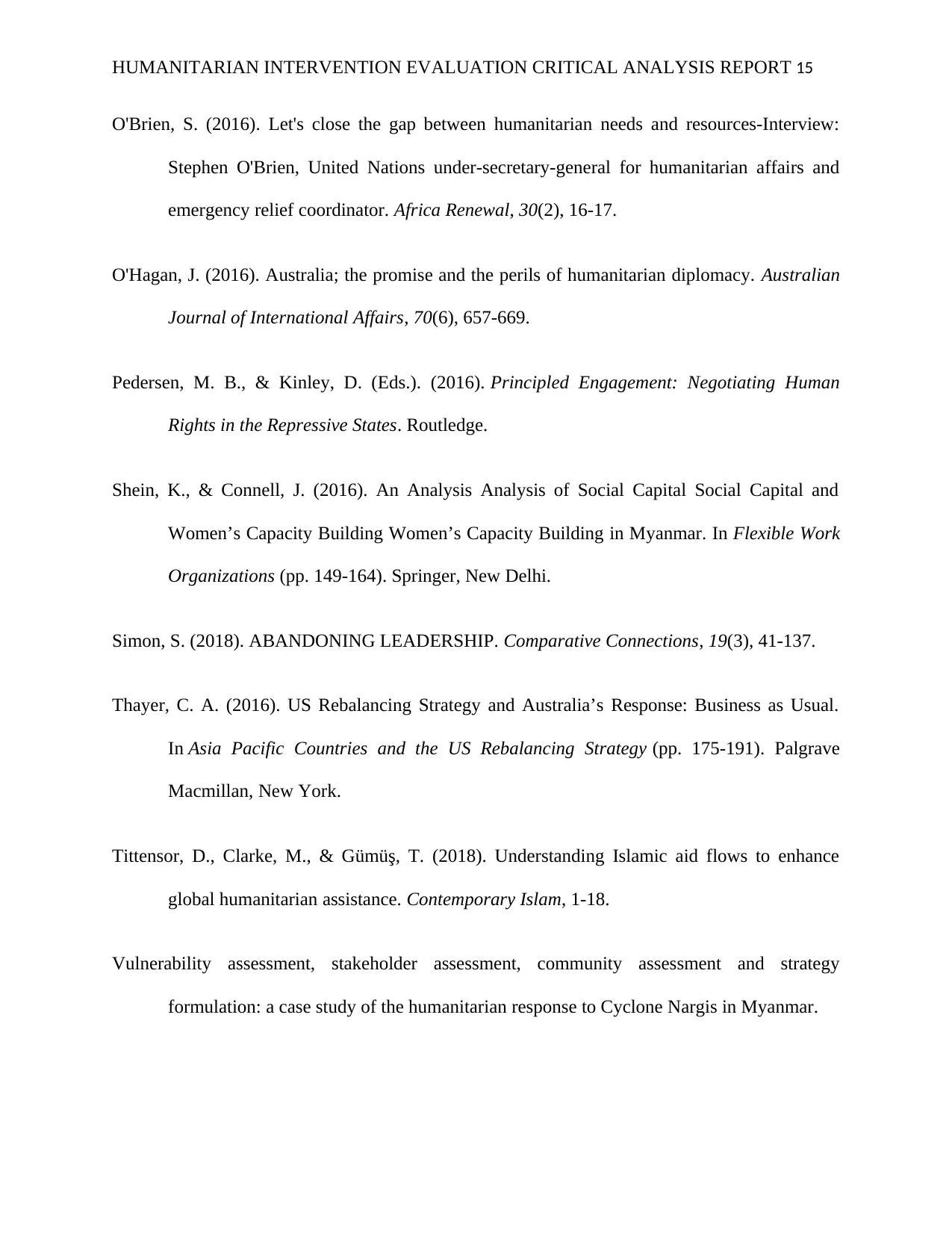
HUMANITARIAN INTERVENTION EVALUATION CRITICAL ANALYSIS REPORT 15
O'Brien, S. (2016). Let's close the gap between humanitarian needs and resources-Interview:
Stephen O'Brien, United Nations under-secretary-general for humanitarian affairs and
emergency relief coordinator. Africa Renewal, 30(2), 16-17.
O'Hagan, J. (2016). Australia; the promise and the perils of humanitarian diplomacy. Australian
Journal of International Affairs, 70(6), 657-669.
Pedersen, M. B., & Kinley, D. (Eds.). (2016). Principled Engagement: Negotiating Human
Rights in the Repressive States. Routledge.
Shein, K., & Connell, J. (2016). An Analysis Analysis of Social Capital Social Capital and
Women’s Capacity Building Women’s Capacity Building in Myanmar. In Flexible Work
Organizations (pp. 149-164). Springer, New Delhi.
Simon, S. (2018). ABANDONING LEADERSHIP. Comparative Connections, 19(3), 41-137.
Thayer, C. A. (2016). US Rebalancing Strategy and Australia’s Response: Business as Usual.
In Asia Pacific Countries and the US Rebalancing Strategy (pp. 175-191). Palgrave
Macmillan, New York.
Tittensor, D., Clarke, M., & Gümüş, T. (2018). Understanding Islamic aid flows to enhance
global humanitarian assistance. Contemporary Islam, 1-18.
Vulnerability assessment, stakeholder assessment, community assessment and strategy
formulation: a case study of the humanitarian response to Cyclone Nargis in Myanmar.
O'Brien, S. (2016). Let's close the gap between humanitarian needs and resources-Interview:
Stephen O'Brien, United Nations under-secretary-general for humanitarian affairs and
emergency relief coordinator. Africa Renewal, 30(2), 16-17.
O'Hagan, J. (2016). Australia; the promise and the perils of humanitarian diplomacy. Australian
Journal of International Affairs, 70(6), 657-669.
Pedersen, M. B., & Kinley, D. (Eds.). (2016). Principled Engagement: Negotiating Human
Rights in the Repressive States. Routledge.
Shein, K., & Connell, J. (2016). An Analysis Analysis of Social Capital Social Capital and
Women’s Capacity Building Women’s Capacity Building in Myanmar. In Flexible Work
Organizations (pp. 149-164). Springer, New Delhi.
Simon, S. (2018). ABANDONING LEADERSHIP. Comparative Connections, 19(3), 41-137.
Thayer, C. A. (2016). US Rebalancing Strategy and Australia’s Response: Business as Usual.
In Asia Pacific Countries and the US Rebalancing Strategy (pp. 175-191). Palgrave
Macmillan, New York.
Tittensor, D., Clarke, M., & Gümüş, T. (2018). Understanding Islamic aid flows to enhance
global humanitarian assistance. Contemporary Islam, 1-18.
Vulnerability assessment, stakeholder assessment, community assessment and strategy
formulation: a case study of the humanitarian response to Cyclone Nargis in Myanmar.
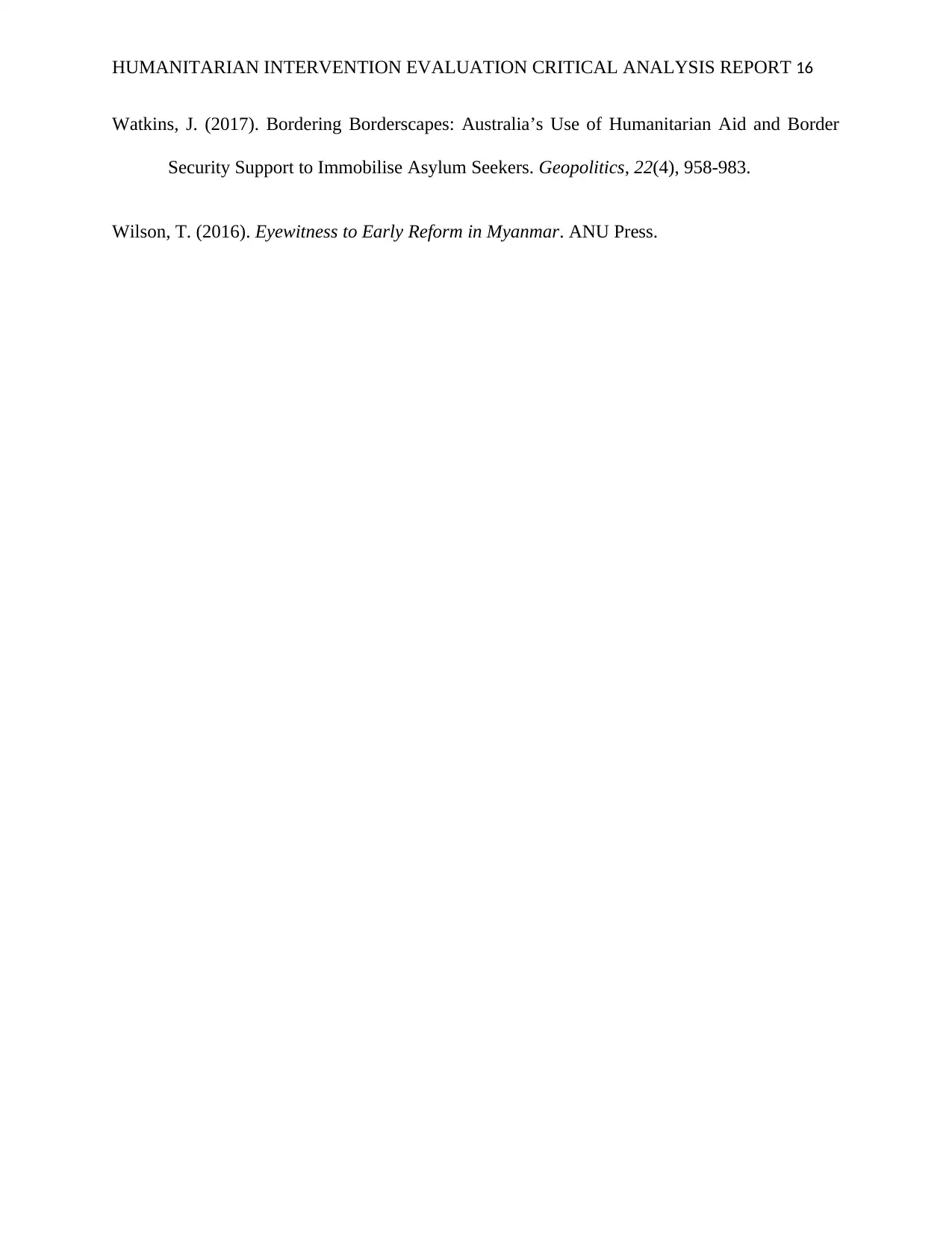
HUMANITARIAN INTERVENTION EVALUATION CRITICAL ANALYSIS REPORT 16
Watkins, J. (2017). Bordering Borderscapes: Australia’s Use of Humanitarian Aid and Border
Security Support to Immobilise Asylum Seekers. Geopolitics, 22(4), 958-983.
Wilson, T. (2016). Eyewitness to Early Reform in Myanmar. ANU Press.
Watkins, J. (2017). Bordering Borderscapes: Australia’s Use of Humanitarian Aid and Border
Security Support to Immobilise Asylum Seekers. Geopolitics, 22(4), 958-983.
Wilson, T. (2016). Eyewitness to Early Reform in Myanmar. ANU Press.
1 out of 16
Related Documents
Your All-in-One AI-Powered Toolkit for Academic Success.
+13062052269
info@desklib.com
Available 24*7 on WhatsApp / Email
![[object Object]](/_next/static/media/star-bottom.7253800d.svg)
Unlock your academic potential
© 2024 | Zucol Services PVT LTD | All rights reserved.





